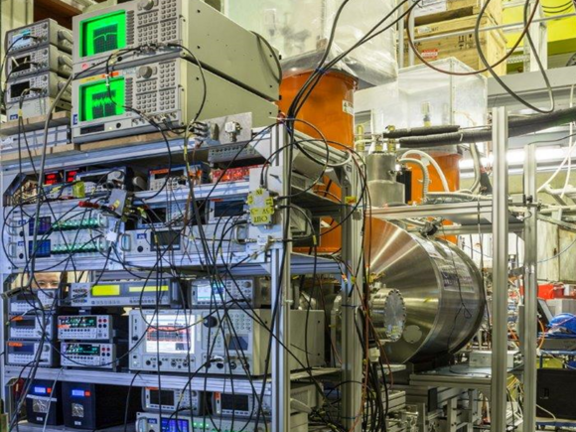High-precision experiments with single charged particles using modern Penning-trap systems allow to perform ultra-high precision measurements of masses, magnetic moments, and fundamental constants. These experiments provide stringent charge-, parity-, and time (CPT) reversal symmetry tests via magnetic moment and charge-to-mass ratio measurements with protons and antiprotons. They enable magnetic moment measurements of light nuclei, tests of quantum electrodynamics via precision (mass) spectroscopy of highly-charged ions, tests of the electroweak force with single molecular ions, as well precision mass measurements of radioactive ions. They also contribute to searches for exotic physics.
Since these precision experiments with trapped ions are limited by particle temperature, advanced particle cooling is crucial for ultra-high precision Penning-trap measurements. Thus, improved cooling techniques that can reliably achieve particle energies lower than those attained by the commonly used resistive cooling systems have to be developed.
In two recent articles published in "Physical Review Letters", the BASE Collaboration reports on major improvements in particle cooling in cryogenic multi-Penning-trap systems.
In a Penning-trap experiment, advanced sympathetic laser cooling of a single proton by laser-cooled 9Be+ mediated by image currents was performed. A new temperature measurement trap (TMT) has been implemented into the Penning-trap system that offers temperature resolution in the mK-range due to an axial frequency shift of 470 Hz/K (axial) arising from an optimized quadratic magnetic field inhomogeneity. In addition, the cooling process has been optimized through numerical simulations. These improvements led to axial temperatures of a single proton in the Penning trap down to about 170 mK, which constitutes a factor of 15 improvement compared to the previous record.
The improved sympathetic cooling technique is applicable to any charged particle and paves the way towards the next generation of high-precision Penning trap measurements with particles that require sympathetic cooling with separate trapping regions.
Please read more in the Physical Review Letters article.
In another Penning-trap experiment, non-destructive sub-thermal cooling of the modified cyclotron mode of a single trapped antiproton was performed. A sub-thermal cooling device, that consists of two stacked Penning traps, a cooling trap (CT) and an analysis trap (AT), and its attached particle manipulation electronics has been implemented. The application of a CT-based optimized Maxwell-daemon-cooling protocol allowed to achieve for single trapped antiprotons temperatures T+ = E+/kB below 200 mK, at a particle preparation time shorter than 500 s. This is the fastest sub-thermal resistive cooling of a single particle in a Penning trap that has ever been demonstrated.
The improved cooling method will have enormous impact on multi-Penning-trap experiments that measure magnetic moments with single nuclear spins for tests of matter/antimatter symmetry, high-precision mass-spectrometry, and measurements of electron g-factors bound to highly-charged ions that test quantum electrodynamics.
Please read more in the Physical Review Letters article.
Original publications:
Image-Current Mediated Sympathetic Laser Cooling of a Single Proton in a Penning Trap Down to 170 mK Axial Temperature
C. Will, M. Wiesinger, P. Micke, H. Yildiz, T. Driscoll, S. Kommu, F. Abbass, B. P. Arndt, B. B. Bauer, S. Erlewein, M. Fleck, J. I. Jäger, B. M. Latacz, A. Mooser, D. Schweitzer, G. Umbrazunas, E. Wursten, K. Blaum, J. A. Devlin, C. Ospelkaus, W. Quint, A. Soter, J. Walz, C. Smorra, and S. Ulmer (BASE Collaboration)
Phys. Rev. Lett. 133, 023002 (2024)
DOI: https://doi.org/10.1103/PhysRevLett.133.023002
Orders of Magnitude Improved Cyclotron-Mode Cooling for Nondestructive Spin Quantum Transition Spectroscopy with Single Trapped Antiprotons
B. M. Latacz, M. Fleck, J. I. Jäger, G. Umbrazunas, B. P. Arndt, S. R. Erlewein, E. J. Wursten, J. A. Devlin, P. Micke, F. Abbass, D. Schweitzer, M. Wiesinger, C. Will, H. Yildiz, K. Blaum, Y. Matsuda, A. Mooser, C. Ospelkaus, C. Smorra, A. Soter, W. Quint, J. Walz, Y. Yamazaki, and S. Ulmer (BASE Collaboration)
Phys. Rev. Lett. 133, 053201 (2024)
DOI: https://doi.org/10.1103/PhysRevLett.133.053201
Weblinks:
CERN News
HHU News
BASE Website (CERN)
BASE experiment page (Division Blaum) at MPIK

